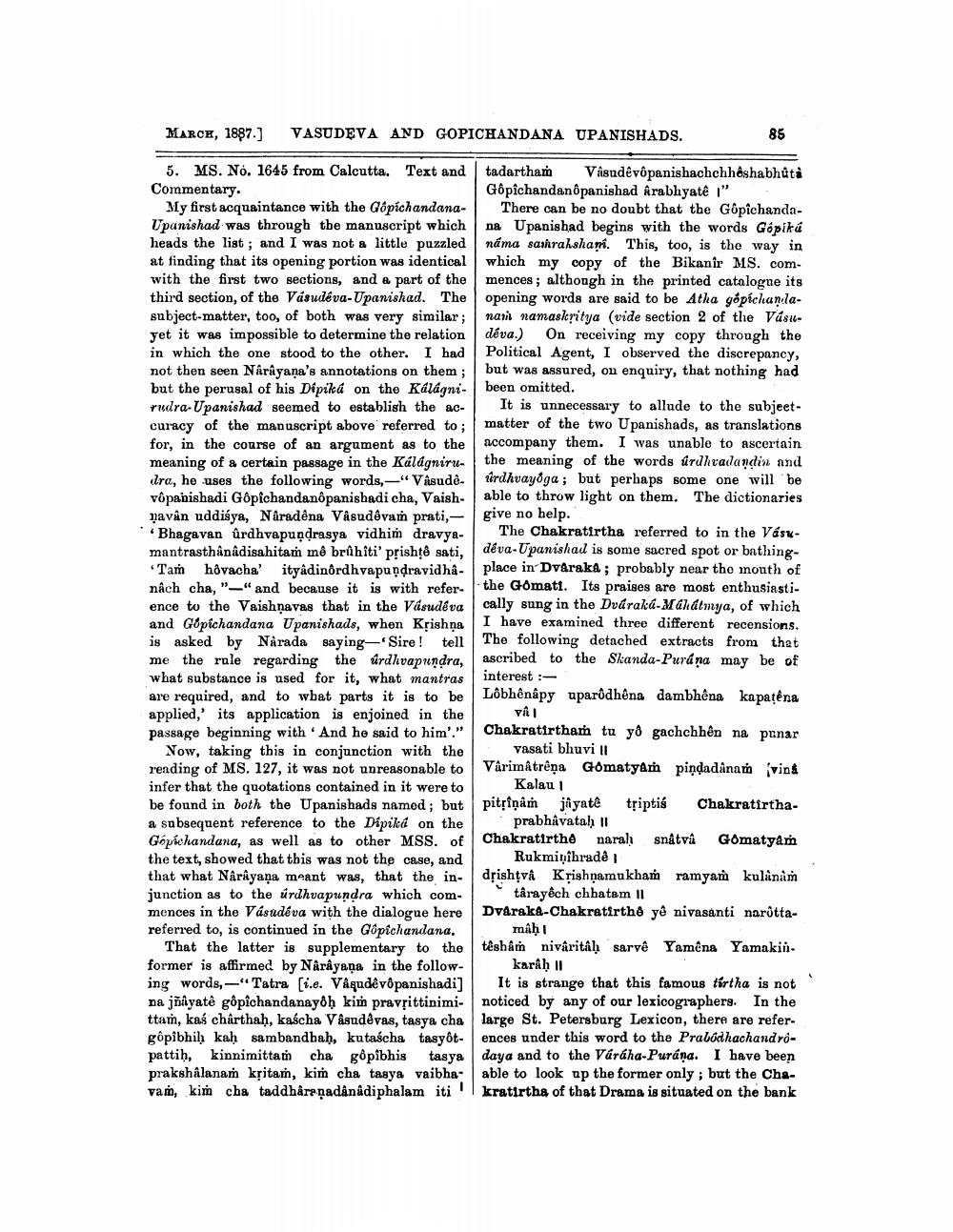________________
MARCH, 1887.)
VASUDEVA AND GOPICHANDANA UPANISHADS.
85
5. MS. Nó. 1645 from Calcutta. Text and tadartham Vasudevopanishachchhoshabhůta Commentary.
Gopichandan opanishad Arabhyaté " My first acquaintance with the Gópíchandana- There can be no doubt that the GopichandaUpanishad was through the manuscript which na Upanishad begins with the words Gópiká heads the list; and I was not a little puzzled náma sarhrahshami. This, too, is the way in at finding that its opening portion was identical which my copy of the Bikanir MS. comwith the first two sections, and a part of the mences; although in the printed catalogue its third section, of the Vásudeva-Upanishad. The opening words are said to be Atha gopichandasubject matter, too, of both was very similar; nari namasleritya (vide section 2 of the Vásuyet it was impossible to determine the relation déva.) On receiving my copy through the in which the one stood to the other. I had Political Agent, I observed the discrepancy, not then seen Narayana's annotations on them; but was assured, on enquiry, that nothing had but the perusal of his Dipika on the Kálágni. been omitted. rudra Upanishad seemed to establish the ac- It is unnecessary to allude to the subjeetcuracy of the manuscript above referred to; matter of the two Upanishads, as translations for, in the course of an argument as to the accompany them. I was unable to ascertain meaning of a certain passage in the Kálágniru- the meaning of the words úrihvadlandin and dra, he uses the following words," Vasude- tirdhvayoga; but perhaps some one will be vôpanishadi Gopichandanôpanishadi cha, Vaish. able to throw light on them. The dictionaries navån uddisya, Náradêna Vasudevam prati, - give no help. Bhagavan ûrdhvapuadrasya vidhim dravya
The Chakratirtha referred to in the Vásrmantrasthånadisahitam mê brâhiti' prishtê sati, dēva Upanishad is some sacred spot or bathing
Tam hôvacha' ityadinôrdhvapundravidha- place in Dvaraka; probably near the mouth of nach cha, "_" and because it is with reference to the Vaishnavas that in the Vasudeva cally sung in the Dváraká Mandtmya, of which and Gopichandana Upanishads, when Krishna I have examined three different recensions. is asked by Nárada saying-Sire! tell The following detached extracts from that me the rule regarding the urdhvapundra, ascribed to the Skanda-Purd na may be of what substance is used for it, what mantras interest :are required, and to wbat parts it is to be Lôbhênapy uparôdhêna dambhêna ka patena applied,' its application is enjoined in the vil passage beginning with. And he said to him'." | Chakratirtham tu y8 gachchhên na panar
Now, taking this in conjunction with the vasati bhuvi !! rending of MS. 127, it was not unreasonable to Värimâtrena Gomatyam piņdadanam vind infer that the quotations contained in it were to
Kalau be found in both the Upanishads namod; but pitpiņam jîyatê triptis Chakratirthaa subsequent reference to the Dipika on the prabhåvatah 11 Gópíchandana, as well as to other MSS. of Chakratirthe narah snätva Gomatyam the text, showed that this was not the case, and Rukminihrade that what Narayana meant was, that the in- dộishțvâ Krishņamukham ramyam kulanan junction as to the urdhvapundra which com- târayêch chhatam 11 mences in the Vásudeva with the dialogue here Dvaraka-Chakratirthể yê nivasanti naróttareferred to, is continued in the Gópichandana. | mahi
That the latter is supplementary to the têshâm niväritâh sarve Yamêna Yamakinformer is affirmed by Narayana in the follow karah II ing words, —"Tatra [i.e. Vâqudê vôpanishadi) | It is strange that this famous tártha is not pa jñiyatê gopichandanayoh kim pravrittinimi- noticed by any of our lexicographers. In the ttam, kaś chârthah, kaścha Vasudevas, tasya cha large St. Petersburg Lexicon, there are refer. gôpibhih kah sambandhah, kutaścha tasyot- ences under this word to the Prabodhachandrópattih, kinnimittam cha gôpibhis tasya | daya and to the Váráha-Purana. I have been prakshâlanam ksitam, kim cha tasya vaibha- able to look up the former only; but the Chavan, kim cha taddhårenadânâdiphalam iti' kratirtha of that Drama is situated on the bank




